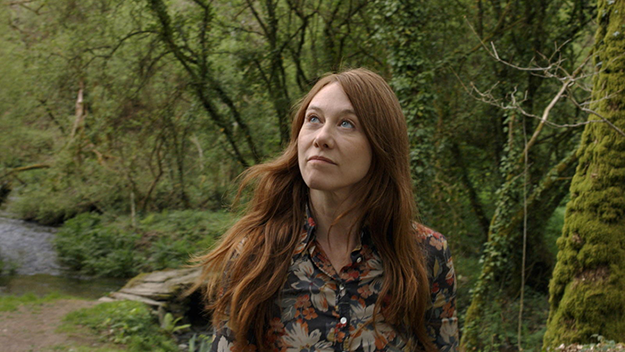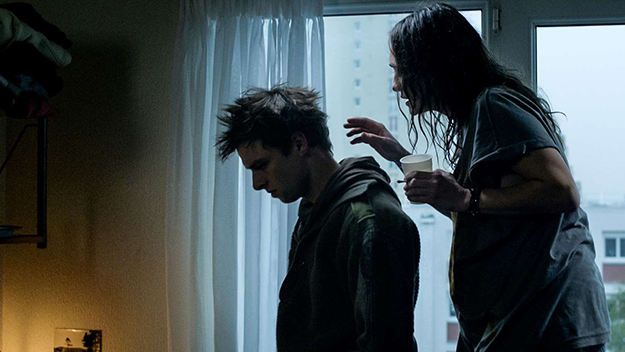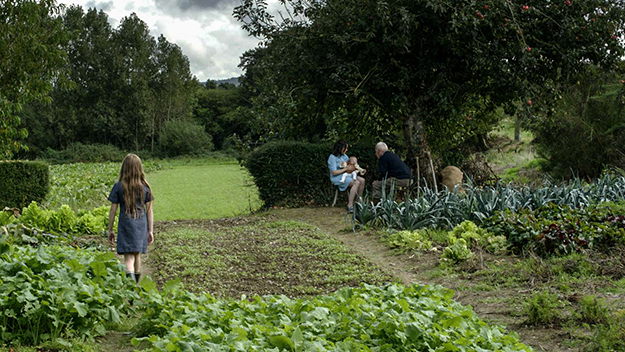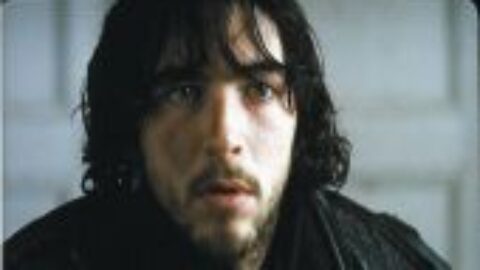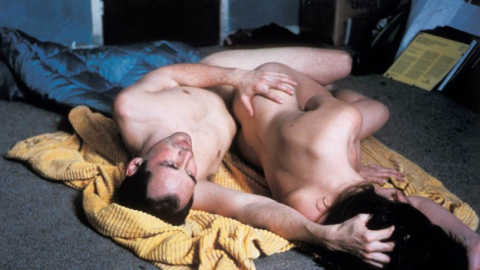ND/NF Interview: Pascale Breton
Teaching a class on art history at the University of Rennes, Françoise Diraison (Valérie Dréville) pauses on Nicolas Poussin’s Et in Arcadia ego. In a darkened lecture hall she stands in front of a projected slide of the 17th-century painting encouraging her students to examine the epitaph that gives the piece its title. Quite literally inhabiting the image of art’s necessity in the light of death (the acknowledged reading of Poussin’s painting), Breton blurs the tidy line between subject and object, art, and art historian. The image also echoes a later dream sequence during which Françoise sees a Sphinx figure in the middle of a vision of Rennes overrun by vegetation, in an oneiric series of overlapping cross-fades. Ostensibly a film about this woman’s return to Brittany where she’ll be haunted by memories she’d long suppressed, Pascale Breton’s Suite Armoricaine is also a film about the nourishing power of art, of cinema.
Françoise’s introspection and art appreciation (she visits museums and gives talks on Medieval theology in Renaissance painting) are balanced by the parallel and increasingly intertwined story of Ion (Kaou Langoët), a geography student at the University. Creating a fresh new start for himself in Rennes, Ion begins dating a pretty blind girl, Lydie, and plunges himself into his studies only to have his newly balanced life threatened by the return of his homeless mother (Elina Löwensohn), who knew Françoise back in their punk-rock days. Ion and Françoise’s paths don’t just cross as much as they lap into one another—Breton’s main visual trope may be the lush greenery of Brittany’s countryside but her film’s narrative structure mirrors a gentle brook not unlike the one Françoise finds herself returning to at film’s end. Quite literally stumbling into one of her lectures, Ion finds in the red-headed professor an inspiring force; we later see him trade his geography textbooks for visits to the museum, as if, finally at wit’s end having been displaced from his dorm room by mom’s “friends,” he can only find respite in the sublimity of art.
In the July/August 2006 issue, FILM COMMENT lauded Pascale Breton as a director who “excels in the precise invocation of place—particularly the nexus at which land- and mindscape merge.” The description feels just as apt in regards to her second feature, Suite Armoricaine, which fuses memory and topography to create a dizzying portrait of returning and finding a home. True to its title, the film feels like an instrumental composition for and about Armorica, the ancient name of the part of Gaul that includes Brittany. Suite Armoricaine screens March 21 and 22 in New Directors / New Films.
The film is an intimate affair but it also has these larger concerns which speak to punk-rock, geography, art history, ethnography, even a little bit of mythology…
[Laughs] Because it takes place in a university! At university you get all these paths of knowledge. A university welcomes this very classical idea of knowledge—like history of Renaissance art—but it also welcomes new approaches, like these men who are asking her questions about our lives [as Bretons]. I started with this idea of setting a film in a university, which is not done in France. In America you have all these films which are really different, but we don’t show a lot of the university in France. I think this is because generally filmmakers didn’t go to university. They go to the sort of schools for privileged students, or they don’t go at all. But I’ve been to university. I studied geography. I wanted to show this because this is a place that allows us to talk about our human life. To tackle these large questions, like a place between childhood and young age, how you get into the world. It all started with the university. So I started with geography and history of art which are two different approaches to landscape.
It also was a way to talk about my generation. When we were young, there was a very strong punk-rock scene in Rennes. It’s about all these things, but it’s because nobody’s talked about them like this before. It’s a very local history and the way we’ve been living. In Brittany, what I’m talking about seems very normal.
As you talked about childhood and growing up, and the university setting, there don’t seem to be that many characters who are “adults” in the traditional sense—as in, grownups who are happy with their jobs, who are married and settled down. Everyone seems to have this youthful, vibrant energy. I’m thinking of Catherine dancing in her apartment, or Moon just drifting away. The grownups seem just like older college people.
[Laughs] Yes, it’s true! Because it’s something about my generation—a lot of people who didn’t really grow up. We became like young people, really. I don’t agree completely with what you say: I mean, there’s the man who runs the library. He’s certainly a man who’s happy with his job, and he’s in charge of this important library. And you know, when I thought of him, I pictured him with two or four children. And he’s happy with his life. I suppose that when you see Françoise in Paris, in that world of very normal couples being happy, [she seems out of place]. But then she comes back to the place where she was in her twenties, and this also brings her back to her younger years. So she’s looking for her youth, in a way. And as the film goes on she gets involved with younger people.
All of this is happening because she’s at the university—it’s a free-spirited place. It’s very equal. When you live in Paris, there is a very strong hierarchy between people. People don’t meet so much between different ages, different social classes. In Brittany, and especially in Rennes, they don’t do that. So she comes back to a different kind of way of living, and she accepts it.
I wanted to talk about the way the story is structured, particularly about the moments when the film rewinds itself, in a way, and has us return to a scene but from a different point of view.
With the times when the film goes into the past, and changes point of view, I was trying to stress the moments when Ion and Françoise meet. You know, like when he falls inside the classroom. They cross paths, but they don’t see much of each other throughout the film. But it creates a link between them. When we go back, we get to see very precisely what happened before every meeting.
When you have a film with several characters, it’s hard to constantly change the point of view. You go from one character to another. Here I wanted to take the spectator into a flow, telling the whole story. You follow a version of the story, and the character you follow is not so important: you can follow Françoise, or Ion, or Lydie, sometimes. You follow all these secondary characters. It functions like a description of the university—of how the people live together and what types of feeling lie there inside.
It’s like La Comédie humaine, you know. Balzac can change the character, but still every part of the film changes the view of the audience towards the world. And when you go back into the past, it also gives the feeling that the ground is not so stable, like in the [Poussin] paintings, and in that final shot. When you’re living, you don’t control everything. So sometimes it’s better to do nothing. And so, when we go back as well, it gives you the feeling of dreaming, when you lose the normalcy of time. It becomes like all these stories where you can’t really tell whether you’re awake or you’re dreaming.
That really comes through in the various lectures we see throughout the film. You film these scenes in extended takes that focus on her students in the class while allowing us to follow her meditations on Renaissance art in the background.
When I was writing, at the beginning, I decided to write all of Françoise’s lectures. Even if they were too long. With all the action we had to cover, I wanted to have full lectures. And when I met my producer and the script was already written, I told him that maybe I should cut off these lecture scenes because people wouldn’t want to give us money to watch these scenes in a film. He told me, no, no, no, I love them, don’t take them out. And I discovered that everyone, even people who don’t care that much for the script, loved the lectures. I still didn’t get much money from certain people, but it wasn’t because of the lectures, it was because of the actors I had chosen.
When we shot, Valérie Dréville, who plays Françoise, really enjoyed the lectures, and finding the poetry in them. We discovered that what would work is if we could both follow the action and what she was saying. So you have this way of being conscious, like when you’re seeing something with someone, and you’re following what they’re telling you as well as what you’re watching. I think it’s not something that’s done a lot in films. During these scenes you have this pleasure, like you have in life, of talking with your friends while listening to what someone else is saying.
I was hypnotized by the film, and I think it’s because of this flow that you’re talking about. And there are these cross-fades into images of nature and Poussin paintings. You get lost in the film. And it teaches you how to watch it.
It’s true. This film is poetic, in way. Tarkovsky talked about that—you can tell a story in the classical way, but that cinema has the ability to convey a kind of poetry. You do it with the tools of cinema, with editing, sound—I used a lot of sounds to create this dream feeling. People do tell me that they get lost in the film. I’m not out to hurt them when I intend for them to get lost. I want to take them to the ending, where the characters disappear and get out of Rennes. And then there’s just the landscape. It’s your chance to watch. It’s a reminder that the world is there. It’s still there. And it belongs to the people.
That final landscape shot resembles the kinds of paintings Françoise teaches.
I wanted to show that at the end, if your eyes are used to looking at things, everything becomes a painting. If you know how to look and hear, if you open your ears and your eyes, you can see art all around you. And we need art to live like we need food and water. And good art!



